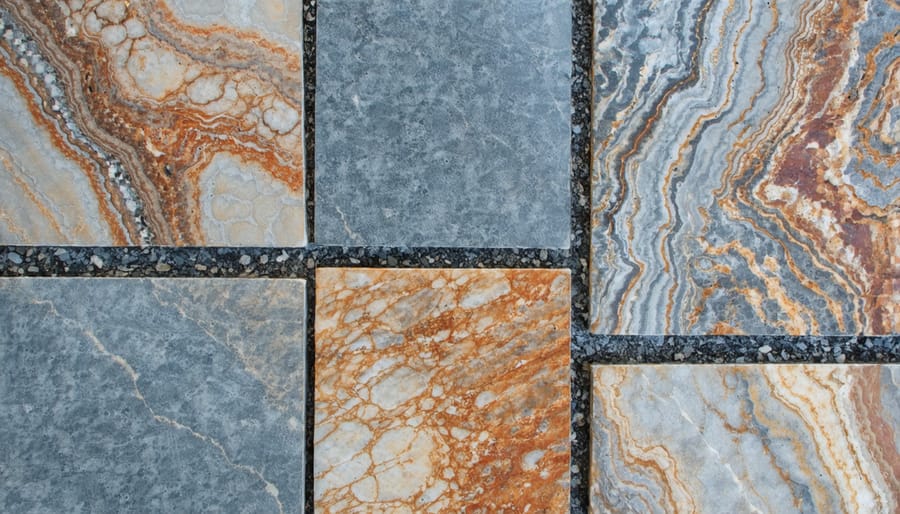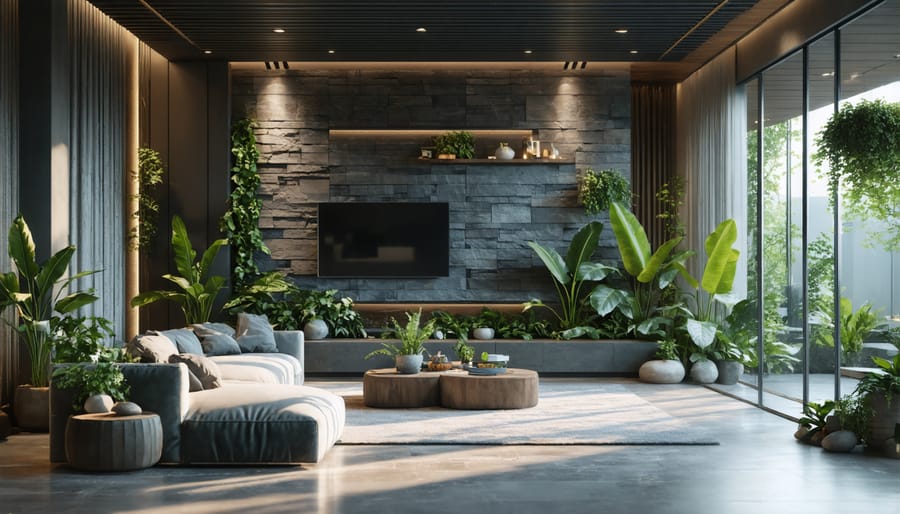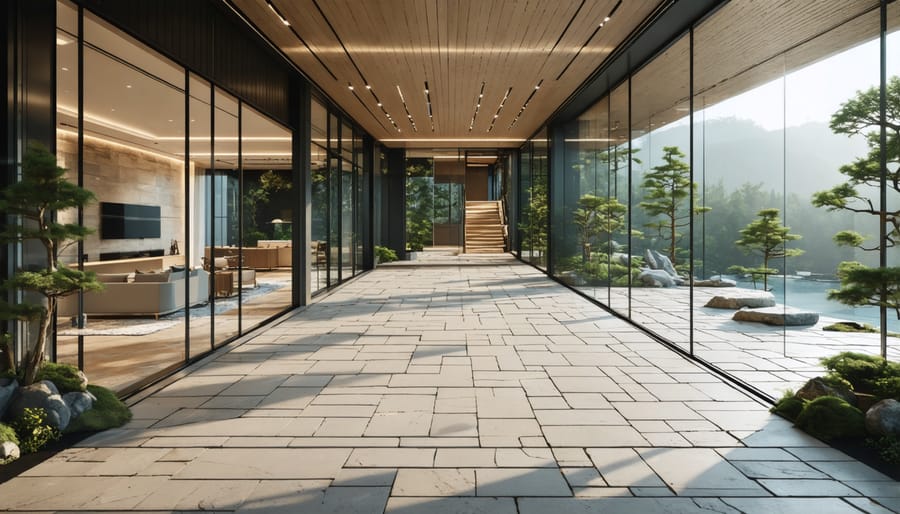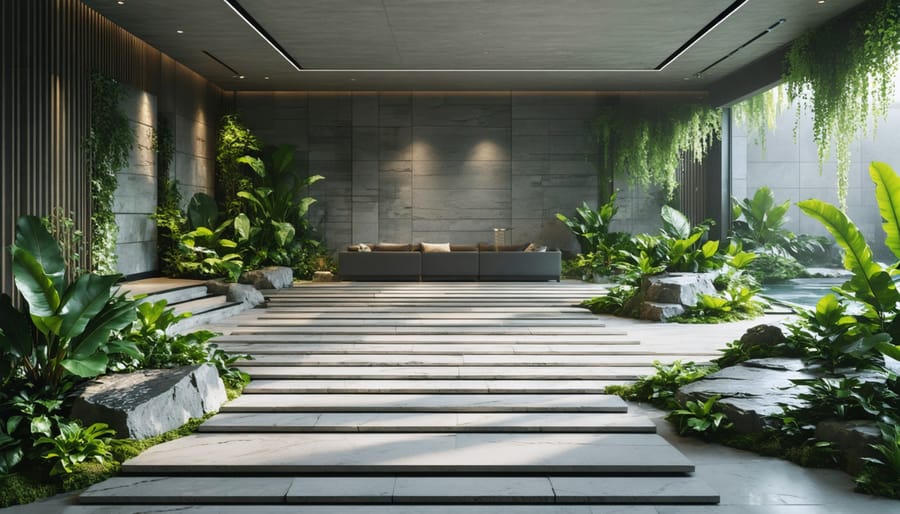In an era where urbanization increasingly disconnects us from nature, biophilic design emerges as a vital bridge between our built environment and the natural world. This design philosophy doesn’t just create aesthetically pleasing spaces – it fundamentally transforms how we live, work, and interact with our surroundings. By integrating natural elements like stone, water, and living plants with thoughtful architectural principles, biophilic design taps into our innate biological connection to nature, promoting wellbeing, reducing stress, and enhancing cognitive function.
Recent studies demonstrate that spaces incorporating biophilic principles can increase productivity by 15%, reduce stress levels by 37%, and significantly improve overall mental health outcomes. From the soaring green walls of Singapore’s Jewel Changi Airport to the nature-inspired curves of Barcelona’s Casa Mila, successful implementations of biophilic design prove its transformative power in both commercial and residential architecture.
As we face growing environmental challenges and increased indoor living, understanding and applying biophilic design principles becomes not just an aesthetic choice, but a crucial strategy for creating healthier, more sustainable spaces that nurture both human wellbeing and environmental consciousness. This comprehensive guide explores how natural stone and other organic elements can be thoughtfully integrated into modern architecture to create spaces that truly connect people with nature.
Why Natural Stone is Perfect for Biophilic Design
The Earth-to-Home Connection
Natural stone serves as one of the most profound connections between our built environment and the Earth’s geological history. Each piece of stone tells a story millions of years in the making, formed through natural processes that have shaped our planet. Different types of natural stone carry unique characteristics that reflect their origins, from the deep metamorphic processes that created marble to the sedimentary layers that formed limestone.
This ancient connection resonates deeply with our innate need to connect with nature. Research has shown that exposure to natural materials like stone can reduce stress, lower blood pressure, and improve overall well-being. The tactile experience of touching stone surfaces, combined with their visual complexity and natural patterns, creates a multi-sensory connection that modern synthetic materials simply cannot replicate.
When we incorporate stone into our living spaces, we’re not just adding a decorative element – we’re bringing a piece of the Earth’s history into our daily lives, creating spaces that feel grounded, authentic, and inherently calming. This profound connection to our planet’s natural processes makes stone an essential element in biophilic design.
Texture and Sensory Experience
Natural stone stands out in biophilic design for its rich textural diversity and sensory appeal. From the smooth, polished finish of marble to the rugged surface of split-face granite, each stone variety offers unique tactile experiences that connect users with the natural world. These varying textures stimulate both visual and tactile senses, creating multi-sensory environments that enhance psychological well-being.
The interplay of light on stone surfaces adds another dimension to the sensory experience. Polished surfaces reflect light dramatically, while honed or brushed finishes create subtle, diffused effects. Natural variations in stone patterns, from the gentle veining in limestone to the dramatic swirls in quartzite, provide visual complexity that mimics patterns found in nature.
Temperature variations inherent in stone materials also contribute to the sensory experience. Stone naturally maintains a cool touch, creating thermal variety within spaces – a key aspect of biophilic design. This quality makes stone particularly effective in creating transitions between indoor and outdoor spaces, where temperature gradients help users feel more connected to the natural environment.
When selecting stone finishes, designers often combine multiple textures to create rich, layered environments that engage users on multiple sensory levels. This thoughtful integration of varied stone textures helps create spaces that feel both grounding and stimulating.

Key Biophilic Design Principles with Natural Stone
Direct Nature Connection
Natural stone serves as one of the most powerful tools in biophilic design, creating immediate and authentic connections with nature. When incorporated thoughtfully, stone elements trigger innate human responses to natural materials, fostering a sense of groundedness and connection to the earth.
The direct use of natural stone in spaces can take many forms, from rough-hewn granite walls that showcase the material’s raw beauty to polished limestone floors that reveal intricate fossil patterns. These elements provide both visual and tactile connections to nature, engaging multiple senses simultaneously. The varied textures, patterns, and colors found in natural stone create rich sensory experiences that synthetic materials simply cannot replicate.
Water features crafted from natural stone further enhance this connection, combining two fundamental natural elements. The sound of water trickling over stone surfaces adds an auditory dimension to the sensory experience, while the interplay of light and water on stone creates dynamic visual effects throughout the day.
To maximize the impact of direct nature connection, designers often position stone elements where they can be both seen and touched. This might include stone seating areas, textured wall surfaces at hand height, or carefully positioned stepping stones in transitional spaces. The geological story inherent in each piece of stone – its formation, striations, and unique characteristics – provides an authentic link to the natural world, making it an invaluable tool in biophilic design.

Natural Patterns and Processes
Natural stone’s inherent patterns and textures create a direct connection to the earth’s geological processes, making it a powerful element in biophilic design. These patterns range from the subtle veining in marble to the dramatic striations in quartzite, each telling a unique story of natural formation over millions of years.
The weathering characteristics of stone contribute significantly to its biophilic appeal. As stone ages, it develops a patina that enhances its natural beauty and creates an ever-evolving surface that mirrors processes found in nature. This natural aging process can be observed in limestone facades that develop rich, golden hues over time, or in slate surfaces that reveal deeper color variations with exposure to the elements.
Designers can maximize these natural patterns by selecting cuts and finishes that highlight specific characteristics. Book-matching stone slabs creates mirror-image patterns that recall natural symmetry found in butterfly wings or leaf structures. Meanwhile, split-face finishes expose the stone’s natural cleavage planes, creating textural interest that engages both visual and tactile senses.
When incorporating these elements, consider how natural light interacts with the stone throughout the day. Morning and evening light can dramatically enhance the depth of natural patterns, while different finishing techniques can either amplify or soften these effects to achieve the desired biophilic impact.
Light and Space
Natural stone plays a pivotal role in manipulating and enhancing natural light within biophilic design. Different stone finishes interact uniquely with light – polished surfaces create dramatic reflections, while honed finishes offer subtle diffusion of daylight throughout spaces. This interaction between stone and light creates dynamic environments that change throughout the day, connecting occupants to natural rhythms.
The positioning of stone elements relative to light sources significantly impacts spatial perception. Large stone walls near windows can reflect and scatter natural light deeper into interior spaces, while strategically placed stone features can create interesting shadow patterns that evolve with the sun’s movement. Light-colored stones like marble and limestone can brighten spaces, while darker varieties like granite and slate can provide grounding contrast.
Spatial design with natural stone supports biophilic principles through the creation of prospect and refuge spaces. Curved stone walls create flowing pathways that mirror natural landscapes, while stone columns and partitions can define intimate areas within larger spaces. The natural variations in stone patterns and textures add visual depth, making spaces feel more organic and connected to nature.
Height variations in stone installations can create different zones within a space, supporting both social interaction and private reflection. When combined with proper daylighting strategies, stone features can establish clear spatial hierarchies while maintaining visual connections to the outdoors, essential elements of successful biophilic design.
Practical Applications
Interior Spaces
Natural stone elements in interior spaces create powerful connections to nature while delivering timeless beauty and sophistication. For walls, consider installing rough-cut stone veneer panels that add visual and tactile texture, or opt for smooth limestone surfaces that provide a more refined aesthetic. Feature walls using stacked stone or mosaic patterns can serve as striking focal points that ground the space in natural elements.
Flooring presents excellent opportunities for biophilic integration through stone. Large-format granite or marble tiles create seamless transitions between indoor and outdoor spaces, while irregular flagstone patterns evoke natural pathways. Consider combining different stone types and finishes to create visual interest and define distinct areas within open floor plans.
Stone countertops and surfaces in kitchens and bathrooms not only provide practical durability but also introduce organic patterns and textures that stimulate our innate connection to nature. Quartzite and granite selections featuring dramatic veining patterns can become artistic centerpieces that celebrate natural geometry.
Accent pieces and architectural details offer additional ways to incorporate stone. Stone-clad columns, exposed stone archways, or decorative stone inlays can add character while reinforcing the biophilic design narrative. For smaller touches, consider stone vessel sinks, stone-based lighting fixtures, or decorative stone elements that bring natural elements to eye level.
When selecting stone materials, prioritize varieties that complement your overall color palette while maintaining visual connections to the local environment. This creates a coherent design that feels both authentic and purposeful.
Transitional Areas
Natural stone serves as a powerful tool in creating seamless transitions between indoor and outdoor spaces, a key element of biophilic design. By strategically incorporating stone elements that flow from exterior to interior spaces, designers can blur the traditional boundaries of built environments, creating a more harmonious connection with nature.
This transitional effect can be achieved through various applications. Continuous stone flooring that extends from an indoor space through to an outdoor patio creates visual continuity and flow. Vertical stone walls that begin outside and continue indoors provide a strong visual anchor while maintaining material consistency. These design choices help reduce the perceived barrier between internal and external environments.
The selection of stone type plays a crucial role in successful transitions. Materials like limestone, slate, and granite work exceptionally well due to their durability in both indoor and outdoor settings. Using the same stone with different finishes can add subtle variation while maintaining cohesion – for example, a honed finish indoors transitioning to a flamed finish outdoors for better slip resistance.
Thoughtful stone placement can also facilitate gradual transitions. Creating covered outdoor spaces with stone elements that mirror interior features helps establish intermediate zones that feel neither fully indoor nor outdoor. This approach is particularly effective in climates where indoor-outdoor living is desirable year-round.
Consider incorporating features like stone-clad door frames, window surrounds, or structural columns that bridge interior and exterior spaces. These elements serve as natural transition points while reinforcing the connection to the surrounding environment.

Outdoor Living Spaces
Natural stone elements play a pivotal role in creating harmonious outdoor living spaces that embody biophilic design principles. The use of stone in exterior settings creates a seamless transition between built environments and natural landscapes, fostering a deeper connection with nature.
Incorporating stone pathways, patios, and retaining walls helps establish organic flow throughout outdoor areas while providing durability and weather resistance. Materials like limestone, granite, and slate offer varying textures and colors that complement surrounding vegetation and create visual interest. Water features crafted from natural stone, such as fountains or cascading walls, introduce both movement and soothing sounds that enhance the sensory experience.
Vertical stone applications, including accent walls and garden borders, can define spaces while serving as striking focal points. These elements often become host surfaces for climbing plants, creating living walls that blend hardscape with landscape. The thermal mass properties of stone also contribute to microclimate regulation, helping maintain comfortable temperatures in seating areas and gathering spaces.
For maximum biophilic impact, consider using local stone varieties that reflect the region’s natural geology. This approach not only ensures environmental harmony but also creates an authentic sense of place. Combining different stone textures and patterns can create rich, multisensory environments that encourage outdoor engagement and support mental well-being.
Sustainability and Maintenance
Biophilic design inherently aligns with sustainable design practices, offering significant environmental benefits while creating healthier indoor environments. Natural stone, as a core element of biophilic design, contributes to sustainability through its durability, longevity, and minimal processing requirements. Unlike synthetic materials, stone requires less energy for production and doesn’t release harmful volatile organic compounds (VOCs) into indoor spaces.
The thermal mass properties of natural stone help regulate indoor temperatures naturally, reducing the need for artificial heating and cooling. This passive temperature control contributes to lower energy consumption and decreased carbon footprint over time. Additionally, stone’s durability means fewer replacements are needed throughout a building’s lifetime, minimizing waste and resource consumption.
However, successful implementation of biophilic design requires thoughtful consideration of long-term maintenance. While maintaining natural stone surfaces is relatively straightforward, it’s essential to establish proper care routines from the outset. Regular cleaning with appropriate products, periodic sealing when necessary, and prompt attention to any damage will ensure the longevity of stone elements.
To maximize sustainability benefits, consider sourcing stone locally to reduce transportation emissions and support regional economies. Also, implement water-efficient cleaning methods and use environmentally friendly cleaning products to maintain the ecological integrity of your biophilic design elements.
Biophilic design principles offer a transformative approach to creating spaces that nurture our innate connection with nature. By incorporating natural stone elements, proper lighting, organic patterns, and vegetation, we can craft environments that enhance well-being, productivity, and emotional health. The science-backed benefits of biophilic design, from reduced stress levels to improved cognitive function, make it a worthy investment for any built environment. Whether you’re planning a large-scale commercial project or a simple home renovation, implementing these principles can create meaningful, lasting impact. As we continue to spend more time indoors, embracing biophilic design isn’t just an aesthetic choice—it’s an essential strategy for creating healthier, more sustainable spaces that truly support human flourishing. Start small, but think holistically, and let nature guide your design decisions.










